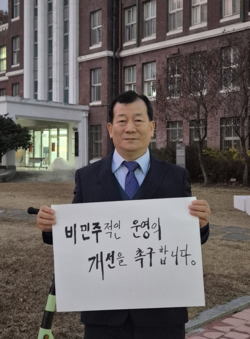With less than two months to go before the class of 2025 begins admitting students, questions are being raised about whether medical schools are ready for the influx of new students.
Sources said on Tuesday that some schools haven't even begun to improve their facilities, such as securing classrooms to accommodate the increased enrollment, while others have been swirling in controversy due to a sudden curriculum overhaul.

Last Friday, the successful applicants for the rolling admissions for the 2025 university entrance examination were announced. The regular admissions will begin on Dec. 31. Applications will be accepted until Jan. 3 next year. According to the government's schedule, all successful applicants will be announced by Feb. 7.
On Sept. 10, the Ministry of Education announced the “Investment Plan for Improving Medical Education Conditions,” pledging support for remodeling existing medical school facilities and building new ones. In the accompanying “National University Medical School Facility Expansion Plan,” the ministry also revealed plans to expand the facilities of nine national university colleges of medicine with increased capacity, excluding Seoul National University.
According to the plan, the nine medical schools will complete the remodeling of existing medical school buildings by February 2025. Each university will develop a plan for new buildings in 2024, start design and construction in 2025, and complete construction in 2028.
However, some of the nine national university colleges of medicine have yet to start remodeling their existing facilities.
Gyeongsang National University College of Medicine initially said it would remodel two buildings, including the learning center, by next February but decided to prepare a plan in January.
University officials explained that the first-year pre-med students who will enter next year are taking classes in liberal arts subjects on the Gajwa campus, where other colleges are located, instead of the Chilam campus, where the medical school is located. The medical school will admit 138 students for the class of 2025, nearly doubling from the existing enrollment quota of 76.
“We are planning to build a new medical school building and remodel the existing building starting next year,” a university official said. “The government budget has yet to reach us. It may take some time as we will start designing after the budget is allocated.”
“The first-year students of the 2025 class, who enter next year, will only take liberal arts classes at the Gajwa campus, not at the Chilam campus, where the medical school is located,” he said. “When they become second-year students in 2026, they will take classes at the medical school, and we are preparing to remodel the existing building to prepare for that.”
Chungbuk National University College of Medicine will start improving the facilities of its medical school's Buildings 1 and 2 on Dec. 24, when winter break begins. The medical school’s new enrollment quota has increased to 125, nearly tripling the current quota of 49 students.
“We have decided to build new medical buildings 4, 5, and 6 and the anatomy lab building. Until then, however, we will restructure the current space for temporary education,” a college official said. “We will tear down the walls of the existing medical building to create a space and fill it with office equipment and computers if necessary.”
Kangwon National University College of Medicine has been remodeling its first medical building since early December and plans to complete it next February.
It plans to secure one large lecture hall and one large lab in the existing medical school building that can accommodate 140 students at a time. Two more large lecture halls will be added through further remodeling. The medical school’s enrollment quota also almost doubled, from 49 students to 91.
“We have begun remodeling work to prepare one large lecture hall and one laboratory,” a medical college official said. “We plan to prepare two more large lecture halls during the summer vacation. The existing lecture hall can accommodate up to 60 people. Still, we plan to build a lecture hall accommodating up to 140 people.”
“It will take three to four years to build a new medical school building, so we want to have a usable space in the meantime,” he said. “I understand that classrooms for small group lectures will be included in the new building. We'll have to make do with what we have.”
However, some experts expressed concerns that rebuilding medical school buildings with large lecture halls could reduce the quality of medical education.
“Most universities are reorganizing their medical school facilities to provide large lecture halls. This will set back the quality of medical education by 20 to 30 years,” a national University College of Medicine professor said. “We used to teach like a cram school lecture, but the best way is to educate students with fewer professors, like small group discussions, and interact with one another.”
“Building large lecture halls means we have to teach like we used to,” he said. “The problems with large lecture halls won't be apparent or felt right now. However, when they become medical students practicing earnestly, the problems will become visible.”
Chonnam National University College of Medicine struggles with curriculum overhaul

Chonnam National University College of Medicine is amid a curriculum reorganization. Professors pointed out that the university is reorganizing the medical curriculum without sufficient discussion.
According to Professor Lim Young-chai of the Department of Pharmacology, the school unveiled the revised curriculum to professors on Aug. 8. The reorganization plan reportedly included a proposal to consolidate the second year of pre-med and the fourth year of medical school into a six-year course.
Professors of basic medicine, including Lim, protested the plan, saying there was no prior discussion of the proposal and that the subsequent curriculum reorganization process was conducted in a way that did not fully reflect their opinions.
The revised curriculum was presented to the Academic Affairs Committee on March 3, but it was put on hold and will be reviewed again in two to three weeks.
“When the curriculum reorganization plan was first presented to professors, many courses were unilaterally scrapped without the knowledge of the professors in charge,” Professor Lim said. They weren't informed in advance or asked for their opinions. Later, meetings were organized with only representatives from each classroom, and there was insufficient communication.
“It's not easy to reorganize a curriculum. It's a time-consuming process. First, professors must be informed about the process and fully discuss it. Once the reorganization is passed, it's hard to change it,” Lim said. “If the process is fully disclosed and opinions are collected, there is no reason for professors to object.”
Professor Lim expressed concerns that next year's new students will also be affected.
“Medical education has already been through one disruption. If the curriculum is not properly discussed, students will be suspicious, and professors will be confused. Above all, the damage to basic medical education will be great,” he said.
Related articles
- Despite Yoon's removal, medical student quota expansion remains contentious
- University presidents urged not to recruit medical students for 2025
- Only Yoon’s impeachment can heal national trauma, 510 psychiatrists say
- A preordained catastrophe: fewer than 100 applicants for 2025 medical residency
- Medical professors demand removal of 'rebellion chieftain' and reversal of medical student expansion plan
- Asan Medical Center professors, Ulsan medical students urge halt to 2025 medical student quota increase
- Education minister says change in 2025 medical school enrollment quota impossible
- Medical community demands suspension of 2026 freshmen admissions to medical schools

